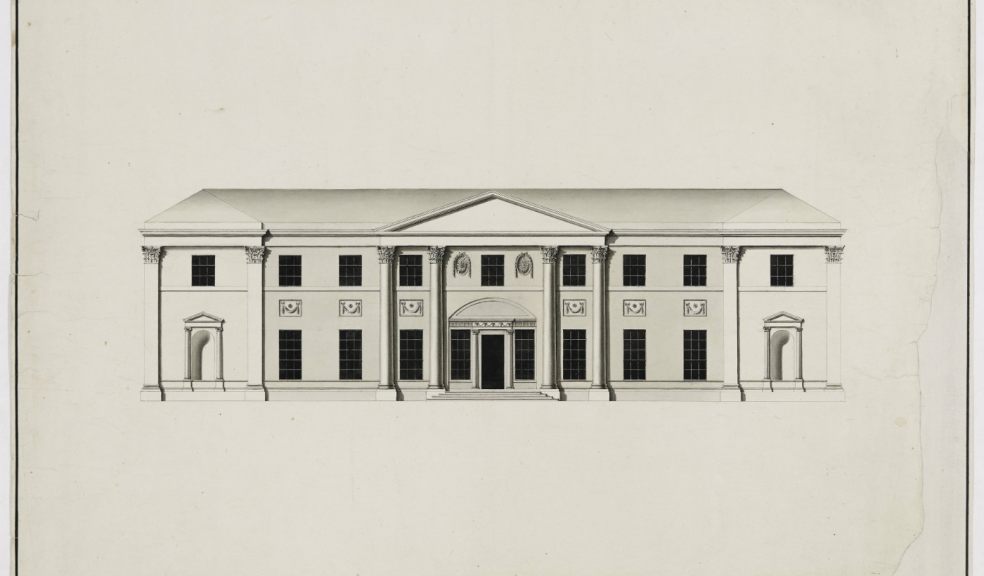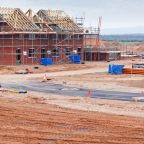
Missing Killerton mansion may have been found
Archaeologists working with the National Trust’s Killerton estate believe they may have found the location of the lost Killerton mansion that was started in 1775, but never completed.
The lost house was re-discovered almost by accident. Rumours of the mansion, three times bigger than the surviving building at Killerton and more befitting of the Acland family’s wealth and status, have circulated for many years - but no-one has been able to find where the building work was located. All that has remained of the mansion are designs by renowned architect, James Wyatt, a few surviving records and three theories about why it was never completed nearly 240 years ago.
An archaeological survey of the parkland included a LIDAR image, which showed something unexpected. In the woods above Killerton house was a large rectangular earth bank. The site had become hidden by laurel, which a team of countryside volunteers cleared, revealing a huge space filled with brick and stone. Renowned architect James Wyatt designed a mansion in the impressive Palladian style, similar to Stourhead or Wyatt’s own Castle Coole, which was rumoured to stand on the hill overlooking the Acland’s estate. It would have been one of the grandest homes in Devon. The size and shape matched the surviving plans of the building and original letters that refer to ‘the house on the hill’. Have the National Trust found the house that Devon never had?
No-one knows for certain why it was never completed, speculation centres around three rumours – one that Sir Thomas Dyke Acland was so distraught over the death of his eldest son and heir that he cancelled the build, another that it was too impractical to get a water supply to the location of the new mansion on the hill, and lastly, that Wyatt, notorious for poor organisation and not completing projects, took on the project but didn’t see it through.
Fi Hailstone of the National Trust, said ‘So much of the site was hidden by laurel that we think that it was planted there to hide the site. As we cleared the laurel it became more and more obvious that some serious works had happened here. We don’t know for sure if it is Wyatt’s abandoned house, but we are planning more archaeological surveys over the summer to find out. I wouldn’t be surprised if Sir Thomas had chosen this spot as it has stunning views over the estate. If this is the site he had in mind, I wish it had been finished; I’d have loved to have seen it.’
The National Trust has opened up the site of the ‘lost’ house to visitors as part of a new experience called ‘Lost Killerton’ which runs from June to the end of September. The Lost Killerton trail will include two more intriguing lost buildings such as a mysterious white folly tower and an ornate orangery, as well as exploring some of the lost landscapes in the parkland.
Andy Bramwell from the National Trust said, ‘It’s amazing to think that this building has been hiding in the woods, just waiting to be found. It’s inspired us to create a new outdoor trail that tells the stories of the other lost buildings and landscapes at Killerton.’
He continued, ‘A team of volunteers have been delving into the archives to find out more about Killerton’s history and discovering the lost house has been like finding the last piece of a jigsaw puzzle. Visitors can come and follow the trail to discover the story of Lost Killerton and find out why the building was abandoned.’
As well as the Lost Killerton trail there will be programme of themed events over the summer, including guided walks and chances to see archaeology in action. Andy said, “Visitors can pick up a trail leaflet and explore Lost Killerton under your own steam, or join one of the regular guided walks. What I’m really looking forward to are the archaeology in action days we’re planning, where the public can come and see history in the making – who knows what we might discover.”
Visitors can see archaeology in action on Monday 26 June to Wednesday 28 June, as archaeologists conduct an earthwork survey at the lost house. Visitors can see more archaeology taking place at the lost house from Monday 17 July to Friday 28 July. Killerton’s mysterious Folly will be investigated by archaeologists hoping to find out more about how and when it was built. This will take place on Tuesday 25 July and Wednesday 26 July, with special guided tours available to the Folly site to see the action.
Further information about Lost Killerton and events at Killerton can be found on the National Trust website: www.nationaltrust.org.uk/killerton
Images:
IDAR image of estate (showing possible lost mansion) - Environment Agency and SW Archaeology
Killerton Mansion design by architect James Wyatt - RIBA


















